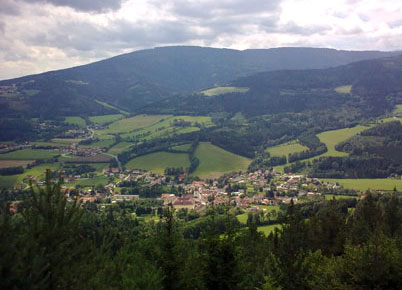To Kirchberg and back
August 2010

Project team members Christopher Burke and Eric Kindel recently returned from the 33rd International Wittgenstein Symposium held in Kirchberg am Wechsel, about 80 km south of Vienna. The symposium is hosted annually by the Austrian Ludwig Wittgenstein Society. Burke and Kindel delivered papers to a two-day workshop 'Picturing social facts: on Neurath's visual language' that ran in parallel with the main philosophy sections (the full symposium program can be found here). The workshop, on 9 and 10 August, was convened by Elisabeth Nemeth and Friedrich Stadler, who offered remarks ('Otto Neurath's picture language revisited') at the start of the first day, then took turns chairing papers.
Burke's paper was titled 'The linguistic status of Isotype', and Kindel's 'Reaching the people: Isotype beyond the West'. Abstracts for these are appended below. Other workshop contributors included Hadwig Kraeutler ('"Rondom Rembrandt" revisited: on Otto Neurath's contributions to visual/museum education and competence-building'; you can find a related paper here), Bart Lootsma ('Out of the wild'), Sophie Hochhäusl ('Otto Neurath: the other modern'), Karl Müller ('Visualizing Europe'), Lada Hanzelinová ('Development of picture statistics in Czechoslovakia in the 1930s'), and Sybilla Nikolow ('"Words divide, pictures unite": Otto Neurath's pictorial statistics in historical context').
In a lecture to the full symposium, Peter Weibel argued that Isotype was essentially a failure ('Bildsprache und wissenschaftliche Visualisierung').
Abstracts for all the papers can be found here.
[appended:]
Christopher Burke, 'The linguistic status of Isotype'
It is ironic that Otto Neurath, one of those responsible for the 'linguistic turn' in philosophy of the twentieth century, should have been concerned during the last twenty years of his life with developing a 'pictorial language'. By using simplified pictograms as components, the Wiener Methode der Bildstatistik (later called Isotype) bypassed verbal language to a great extent, creating the potential for universal understanding of biological, social and economic correlations. However, despite its consistency and rigour, Isotype was not a complete language, and Neurath knew that it never could be. This paper examines the linguistic characteristics of Isotype and describes the deliberate resistance on the part of its creators to develop a full theory behind it.
Eric Kindel, 'Reaching the people: Isotype beyond the West'
Isotype's claim to internationality is embedded in its very name and in the title of Otto Neurath's International picture language (1936), the book that describes Isotype most fully. Isotype's international character is generally located in its techniques of graphic configuration that incorporate pictograms and other simplified graphic imagery to produce compelling and widely understood visual explanations that rely only minimally on verbal language. But just how international did Isotype prove to be when deployed beyond the modernised West where, by far, the bulk of its work was directed?
This paper takes as its case study the export of Isotype to British colonial West Africa in the mid 1950s, where it encountered the only significant test of its suitability in the developing, non-Western world. The paper explores how the international effectiveness of Isotype was pursued, paradoxically, through strategies of locally responsive modification and use. It identifies how shifts in Isotype techniques of graphic configuration and changes in graphic imagery (including pictograms) helped in the adaptation of Isotype to West African contexts. It also considers how the use of vernacular languages together with English amplified Isotype's ability to 'speak' to audiences with force and clarity. Further attention is directed towards Isotype's work 'on the ground' in schools, hospitals and community centres where it was hoped a better understanding of local sites of learning and reception could be gained, an understanding that in turn would better shape Isotype's delivery. And possibly most revealing of Isotype's internationality, the paper reviews attempts to train local people to make Isotype work themselves.



